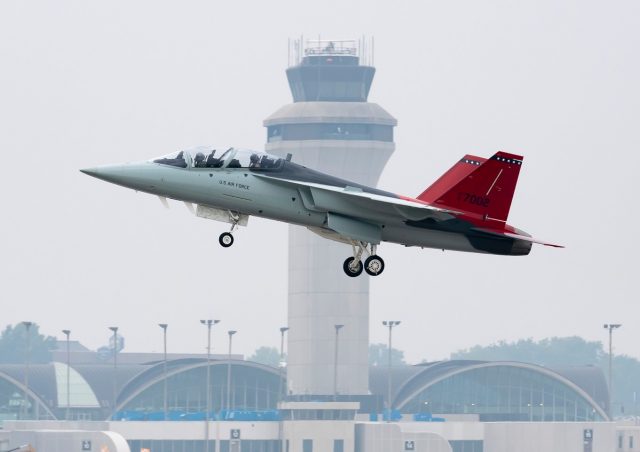The US Air Force’s first T-7A Red Hawk trainer completed its inaugural flight on June 28, marking the start of the engineering and manufacturing development (EMD) phase of the program.
During the 1 hour and 3 minute flight, US Air Force Maj. Bryce Turner, 416th Test Squadron, and Steve Schmidt, Boeing T-7 chief test pilot, validated key aspects of the Air Force’s first advanced trainer to be digitally designed, built and tested.
The aircraft is one of five EMD aircraft that will be delivered to the Air Force Air Education and Training Command for further testing.
“The stable performance of the aircraft and its advanced cockpit and systems are game changers for US Air Force student pilots and instructors alike,” said Turner, whose grandfather and father were both U.S. Air Force fighter pilots. “We’ve come a long way in training since my family role models flew.”
The T-7A’s red tails are a tribute to the Tuskegee Airmen, the first African American US military aviators who flew red-tailed fighters during World War II.
In 2018, the Air Force awarded Boeing a $9.2 billion contract for 351 T-7A advanced trainers, 46 simulators and support. The T-7A will replace the Air Force’s aging T-38 aircraft.
The T-7A moved from firm concept to flight testing in 36 months. A combination of model-based engineering, 3D design and advanced manufacturing increased first-time quality by 75% and reduced assembly hours by 80%.
The all-new advanced pilot training system uses high resolution ground-based training systems and simulators to deliver realistic integrated live, virtual and constructive training capabilities.
Boeing further explains that model-based engineering enabled testing throughout the aircraft’s design and build to help ensure safety before the first flight. The T-7A’s cockpit egress system “is the safest of any trainer,” the company claims.
“This first flight with the Air Force represents our team’s commitment to delivering a new level of safety and training for fighter and bomber pilots,” said Evelyn Moore, vice president and program manager, Boeing T-7 Programs. “We remain focused on engineering ways to better prepare warfighters for changing mission demands and emerging threats.”
“This is an exciting time for the entire team,” said Col. Kirt Cassell, US Air Force T-7A Red Hawk program manager. “The Red Hawk’s digital design integrating advanced training capabilities will drastically improve pilot training for the next generation of fighter and bomber pilots.”



























